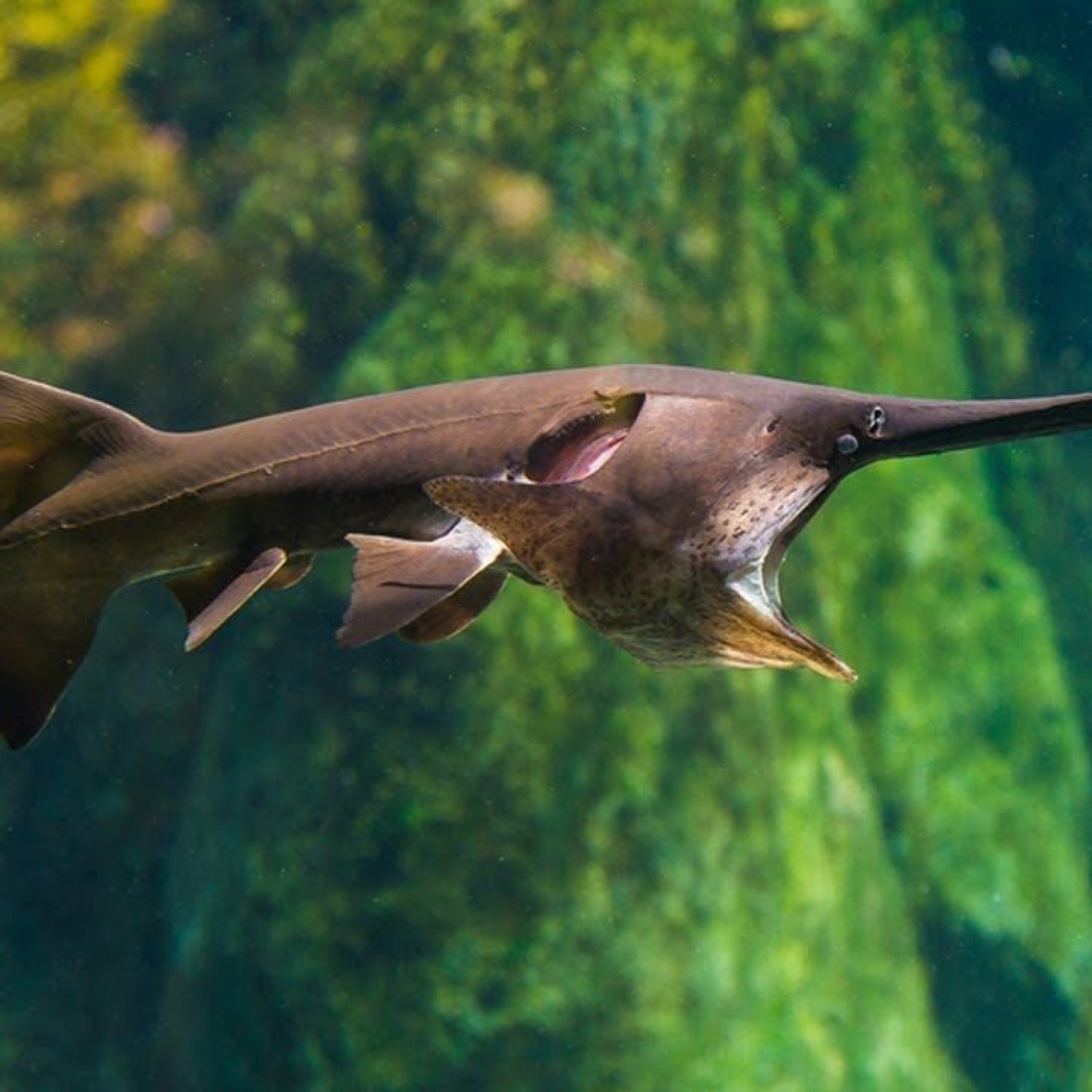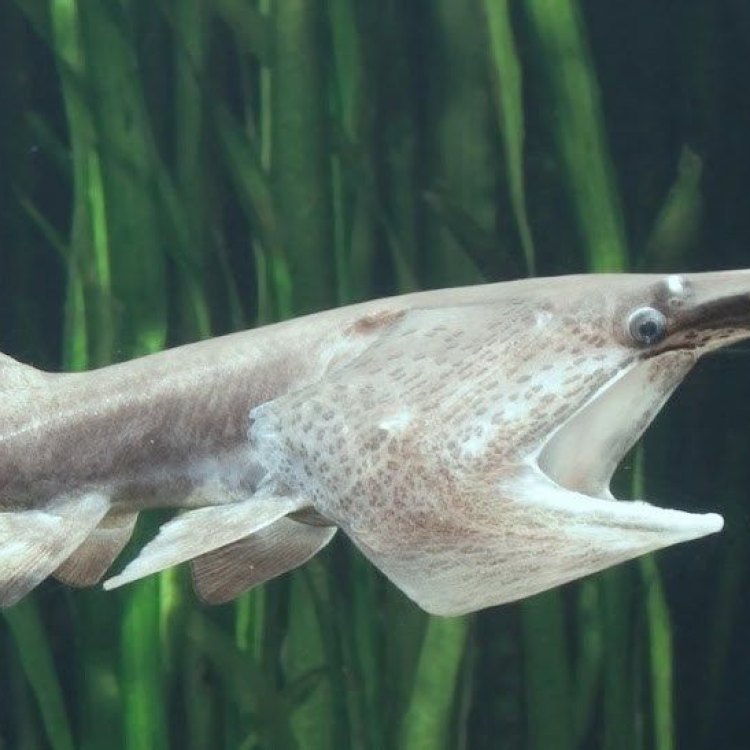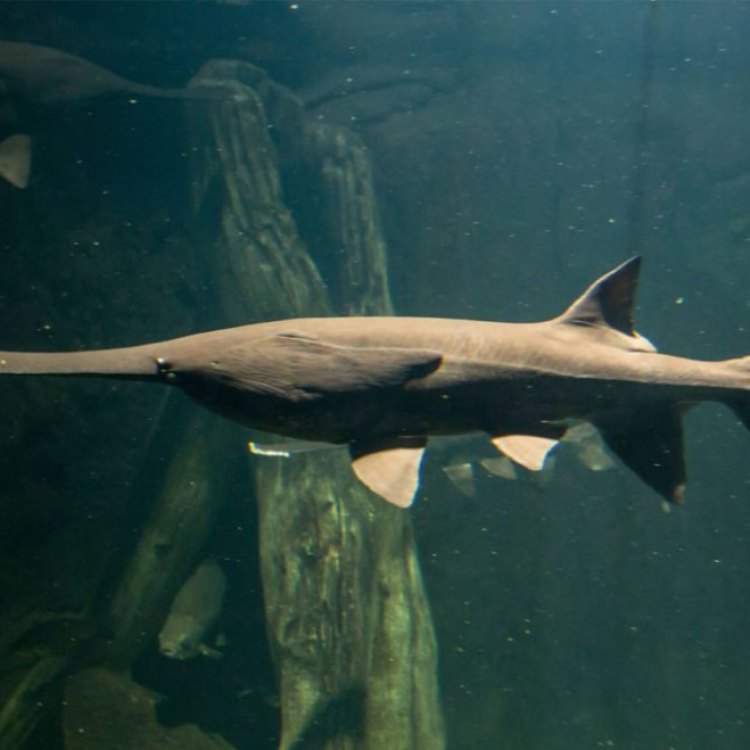
Chinese Paddlefish
Up to 7 meters (23 feet)
The Chinese Paddlefish, also known as the Chinese Swordfish, can grow up to 7 meters long and is native to East Asia. This ancient and elusive aquatic creature, with its elongated and cylindrical body shape, belongs to the Polyodontidae family. Sadly, it is now classified as critically endangered due to overfishing and dam constructions. Let's spread awareness and protect these majestic animals. #chinesepaddlefish #endangeredspecies #aquaticwonders
Animal Details Summary:
Common Name: Chinese Paddlefish
Kingdom: Animalia
Habitat: Freshwater
The Fascinating World of the Chinese Paddlefish: An Incredible Journey Through the Yangtze River
The Chinese Paddlefish, also known as Psephurus gladius, is a majestic and intriguing creature that roamed the waters of the Yangtze River in China for millions of years. However, this ancient species was tragically declared extinct in 2020, sending shockwaves through the scientific community.With a unique appearance, impressive size, and mysterious way of life, the Chinese Paddlefish captures the imagination of many. In this article, we will delve into the extraordinary world of this remarkable fish and explore the factors that led to its extinction Chinese Paddlefish.
The Origins of the Chinese Paddlefish
The Chinese Paddlefish belongs to the kingdom Animalia, phylum Chordata, and class Actinopterygii, making it a vertebrate and ray-finned fish. It is classified under the order Acipenseriformes, a group that includes sturgeons and paddlefishes, and the family Polyodontidae, which comprises only two other species.This fascinating creature has its roots in East Asia, specifically in China, where it was discovered in the Yangtze River. The Yangtze River is the third-largest river in the world, running 3,917 miles from the Himalayas to the East China Sea. It is home to a diverse range of flora and fauna, making it an exceptional habitat for the Chinese Paddlefish.
The Appearance and Physical Characteristics of the Chinese Paddlefish
As its name suggests, the Chinese Paddlefish has a long, slender body with a paddle-like snout, measuring up to seven meters (23 feet) in length. Its body shape is cylindrical, and its skin is characterized by a stunning grayish-blue coloration, making it easily recognizable.One of the most striking features of the Chinese Paddlefish is its elongated snout, which can be as long as a third of its body. This distinctive feature earned it the nickname "elephant fish" by the locals, as it resembles the trunk of an elephant Cuban Cockroach. The snout is lined with electroreceptors, which help the fish detect prey in the murky waters of the Yangtze River.
Another notable physical characteristic of the Chinese Paddlefish is its heterocercal tail, meaning that the upper lobe is longer than the lower lobe. This unique tail structure allows the fish to swim quickly and efficiently through the strong currents of the Yangtze River.
The Life and Habitat of the Chinese Paddlefish
The Chinese Paddlefish was primarily a resident of the Yangtze River, although it was occasionally observed in the Qiantang River as well. It preferred the calmer and deeper areas of the river, where it could easily use its paddle-like snout to forage for food.Being a freshwater species, the Chinese Paddlefish was highly adapted to the rivers and streams of its habitat. It was a filter feeder, meaning that it would swim with its mouth open, filtering out plankton and small fish with its gill rakers. This method of feeding made it a crucial component of the Yangtze River ecosystem, playing a vital role in maintaining a balance between the different species.
The Tragic Extinction of the Chinese Paddlefish
The Chinese Paddlefish had a long history, with fossil evidence dating back to over 7 million years ago. However, the species faced a rapid decline in the 1970s due to overfishing, habitat destruction, and pollution in the Yangtze River. With its slow reproductive rate and low population numbers, the Chinese Paddlefish was extremely vulnerable to human activities.Despite efforts to protect the species, such as a fishing ban and the establishment of conservation areas, the damage was already done. In December 2020, a team of scientists declared the Chinese Paddlefish officially extinct, making it the first large vertebrate species to disappear from the Yangtze River in modern times.
The loss of the Chinese Paddlefish is not only a tragedy in itself, but it also has wider implications for the environment. Its extinction has disrupted the food web in the Yangtze River and has potentially irreversible consequences for other species that depended on it for survival.
The Importance of the Chinese Paddlefish for Natural Language Processing (NLP)
The Chinese Paddlefish is a perfect example of the delicate balance of ecosystems and the impact human activities can have on them. Its extinction serves as a cautionary tale, highlighting the importance of conservation efforts and the need to prioritize the protection of our planet.The incredible journey of the Chinese Paddlefish also presents an exciting opportunity for NLP technology. By analyzing data on this extinct species, scientists can better understand the complex relationships between species and the impact of environmental changes on the natural world.
Conclusion: A Legacy Lives On
The Chinese Paddlefish may be gone, but its legacy lives on. As the symbol of the Yangtze River, it continues to inspire conservation efforts and serves as a reminder of the fragility of our environment.With its remarkable appearance, unique adaptations, and mysterious way of life, the Chinese Paddlefish captured the hearts and minds of many. Although it may no longer roam the waters of the Yangtze River, its story will continue to fascinate and educate people for generations to come.
As we move forward, it is crucial to remember the lessons learned from the extinction of the Chinese Paddlefish and take action to protect the biodiversity of our planet. We have the power to make a positive impact and preserve the natural world for future generations, and it is up to us to do so.

Chinese Paddlefish
Animal Details Chinese Paddlefish - Scientific Name: Psephurus gladius
- Category: Animals C
- Scientific Name: Psephurus gladius
- Common Name: Chinese Paddlefish
- Kingdom: Animalia
- Phylum: Chordata
- Class: Actinopterygii
- Order: Acipenseriformes
- Family: Polyodontidae
- Habitat: Freshwater
- Feeding Method: Filter Feeder
- Geographical Distribution: Yangtze River
- Country of Origin: China
- Location: East Asia
- Animal Coloration: Grayish-blue
- Body Shape: Elongated and cylindrical
- Length: Up to 7 meters (23 feet)

Chinese Paddlefish
- Adult Size: Large
- Average Lifespan: 55 years
- Reproduction: Sexual
- Reproductive Behavior: Unknown
- Sound or Call: Unknown
- Migration Pattern: Unknown
- Social Groups: Solitary
- Behavior: Unknown
- Threats: Overfishing, habitat degradation, and dam construction
- Conservation Status: Critically Endangered
- Impact on Ecosystem: Important keystone species
- Human Use: Fishing, feeding and fertilizer
- Distinctive Features: Long paddle-like snout, absence of teeth
- Interesting Facts: One of the largest freshwater fish species in the world
- Predator: None known

Psephurus gladius
The Chinese Paddlefish: A Critically Endangered Giant of the Freshwater World
Deep within the murky waters of the Yangtze River in China, there once swam a majestic and mysterious creature known as the Chinese Paddlefish. At one time, this unique fish was a common sight in the river, reaching lengths of up to 7 meters and weighing over 300 pounds. But sadly, over the past few decades, this once thriving species has sharply declined in numbers and is now listed as critically endangered. In this article, we will dive deep into the world of the Chinese Paddlefish, exploring its distinctive features, behavior, and the threats it faces in the wild PeaceOfAnimals.Com.One of the most remarkable features of the Chinese Paddlefish is its size. As an adult, it can grow to be larger than a human, making it one of the largest freshwater fish species in the world. It can reach up to 7 meters in length and weigh over 300 pounds, with females generally being larger than males. This size and weight are primarily due to their long lifespan, with the average lifespan of a Chinese Paddlefish being around 55 years. In comparison, most freshwater fish species have a lifespan of only a few years.
The Chinese Paddlefish is a sexual species, with males and females coming together for the purpose of reproduction. However, not much is known about their reproductive behavior, as their habitat has been heavily impacted by human activities, making it difficult to study these fish in their natural habitat. It is believed that they have a low reproductive rate, making them vulnerable to overfishing and other threats.
Another interesting fact about the Chinese Paddlefish is the absence of teeth Cobras. Instead, they have a long paddle-like snout that they use to catch and guide their prey into their mouths. This unique feature has led to them being commonly referred to as the "elephant of the Yangtze" due to their large size and long snout. This snout also plays a crucial role in their feeding behavior, as they use it to sift through the sediment at the bottom of the river for food.
The Chinese Paddlefish is a solitary species, preferring to swim alone rather than in social groups. Not much is known about their behavior as they spend most of their time in the depths of the Yangtze River, making them difficult to observe. What we do know is that they are predators, feeding primarily on small fish, crustaceans, and insects. As an apex predator, they play a critical role in maintaining balance within the river's ecosystem.
Sadly, the Chinese Paddlefish is facing numerous threats that have led to its decline and being listed as critically endangered. The main threat is overfishing, driven by the high demand for their meat and for use in traditional Chinese medicine. These fish are also a popular food fish in Chinese cuisine, with their roe considered a delicacy. The demand for these fish has led to a sharp decline in their numbers, with some experts estimating that their population has decreased by 97% since the 1970s.
In addition to overfishing, the Chinese Paddlefish is also facing habitat degradation and dam construction. The construction of dams on the Yangtze River has disrupted their migration patterns, making it difficult for them to reach their preferred spawning grounds. This has led to a decline in their reproductive success, further contributing to their dwindling numbers. The degradation of their habitat has also resulted in a decline in their prey, making it even more challenging for them to survive.
The decline of the Chinese Paddlefish has had a significant impact on the ecosystem of the Yangtze River. As a keystone species, their presence is crucial in maintaining the balance of the river's food web. Their large size and predatory behavior help to control the population of smaller fish, ensuring that their prey species do not overpopulate and disrupt the delicate balance of the river. With their dwindling numbers, the ecosystem of the Yangtze River is at risk, and action must be taken to protect and conserve this unique species.
Efforts are being made to conserve the Chinese Paddlefish, and in recent years there have been some promising developments. In 2020, a fisherman caught a Chinese Paddlefish that was over 3 meters long and was estimated to be over 25 years old. This discovery gave hope that there may still be a few of these majestic creatures remaining in the wild. Several conservation projects have also been launched, aiming to protect their habitat, reduce overfishing, and promote sustainable fishing practices.
In Chinese culture, the Chinese Paddlefish holds great significance, symbolizing longevity and prosperity. In the past, they were also a source of food and fertilizer for local communities along the Yangtze River. However, with their declining numbers, it is essential to find a balance between human uses and the conservation of this critically endangered species.
In summary, the Chinese Paddlefish is a fascinating and unique creature that calls the Yangtze River its home. With its large size, long lifespan, and distinctive features, it is a remarkable species that must be protected and conserved. By raising awareness and taking action to address the threats facing this species, we can help ensure that future generations can still marvel at the beauty of the Chinese Paddlefish in its natural habitat. We must act now to save this critically endangered giant of the freshwater world.

The Fascinating World of the Chinese Paddlefish: An Incredible Journey Through the Yangtze River
Disclaimer: The content provided is for informational purposes only. We cannot guarantee the accuracy of the information on this page 100%. All information provided here may change without prior notice.












